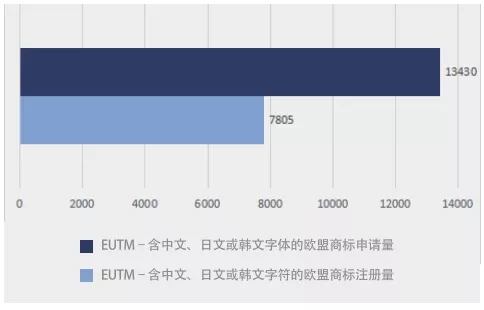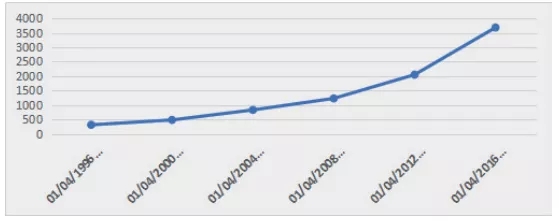
FIG. 1 Comparison of the total number of EU trademark applications containing Chinese, Japanese or Korean characters and corresponding registrations
This article will analyze how to protect these texts by registering EU trademarks by registering EU trademarks Characters, and statistical changes in EU trademark applications covering these characters. The information research in this article uses the database information of the EU Intellectual Property Office (EUIPO), and uses the trademark application data submitted by the Vienna Classification (Vienna Classification) revised by the EU Intellectual Property Office, that is, category 28.03 \u0026 ldquo; Japanese, or Korean Chinese Character \u0026 rdquo;.
EU trademark type
EU Intellectual Property Office \"Trademark Practice Guide\" [1] proposed the following protected trademark types: text trademarks, graphic trademarks , Shape trademarks, location trademarks, pattern trademarks, color trademarks, sound trademarks, dynamic trademarks, multimedia trademarks and holographic graph trademarks. When Chinese, Japanese or Korean characters are registered as EU trademarks, they can only be one of these trademark types.
Because color trademarks and sound trademarks cannot be composed of characters, it can be seen that Chinese, Japanese, or Korean characters cannot be registered as color trademarks and sound trademarks. Color trademarks are only composed of color, and although sound trademarks can be composed of pronunciation of Chinese, Japanese or Korean characters, they cannot be composed of the character itself.
In principle, Chinese, Japanese, or Korean characters can be protected like any other trademark type because they are composed of text and can be regarded as graphics. Specific methods are fixed in the product. If these texts are repeatedly presented, a pattern can be formed, which can be part of the dynamic trademark. It can be included in a trademark with multiple types of medium. Essence
How to register Chinese, Japanese or Korean characters as EU trademarks?
In fact, 13,430 EU veterans based on Chinese, Japanese, or Korean characters (see Table 1), divided into several types of trademarks: 13411 graphics trademarks, 13 shape trademarks, 2 pieces of 2 pieces, 2 pieces, 2 pieces, 2 pieces, 2 pieces, 2 pieces, 2 pieces, 2 pieces, 2 pieces, 2 pieces, 2 pieces, 2 pieces, 2 pieces, 2 pieces, 2 pieces, 2 pieces, 2 pieces, 2 pieces, 2 pieces, 2 pieces, 2 pieces, 2 pieces, 2 pieces, 2 pieces, 2 pieces, 2 pieces, 2 pieces, 2 pieces, 2 pieces, 2 pieces, 2 pieces, 2 pieces, 2 pieces, 2 pieces, 2 pieces. Color trademarks and 4 \u0026 ldquo; other \u0026 rdquo; type trademarks.

Table 1 The status of EU trademarks containing Chinese, Japanese or Korean characters in Chinese, Japanese or Korean in Table 1
In the above -mentioned 7805 EU trademark applications (see Table 2), it includes 7794 graphic trademarks, 8 Piece shape trademarks, 2 pieces \u0026 ldquo; other \u0026 rdquo; type trademarks and 1 color trademark. It should be emphasized that this \u0026 ldquo; color \u0026 rdquo; trademarks' classification in the EU Intellectual Property Office's database is wrong because it is actually a graphic trademark.

Table 2 EU trademark status of Chinese, Japanese or Korean characters registered in accordance with the type of trademark type
In combination with these data, we can obvious the first conclusion All EU trademark applications or registered EU trademarks containing Chinese, Japanese or Korean characters are almost all graphic trademarks. Another obvious fact is that none of them are text trademarks, nor can there be text trademarks, because Vienna classification is only applicable to trademark registration applications containing graphic elements. However, it is important to find any Chinese, Japanese or Korean -based EU trademark registered as a text trademark, and it is very important to explore the reasons.
Although the EU Intellectual Property Office defines the text trademark as any \u0026 ldquo; consists of a letter (uppercase or lowercase), word (capital or lowercase letter), numbers or standard font typography, but only accepts the European Union for the European Union The letter of the official language. Because Chinese, Japanese, or Korean characters are different from the EU's official language, it cannot be registered as a text trademark.
Chinese, Japanese or Korean characters are not regarded as text elements by the EU Intellectual Property Office, but are considered graphic elements. Therefore, its appropriate type of trademark can only be graphic trademarks or any other trademark type containing graphic elements.
The scope of protection and uniqueness of Chinese, Japanese or Korean characters
The reason why all the characters other than the letters of the EU's official language are regarded as Graphic elements, not text elements, because EU consumers do not understand the meaning of these characters. And if consumers do not know these characters, they cannot play the role of trademarks through text elements.
Therefore, the protection of Chinese, Japanese or Korean characters can only be visually visually. Unlike other trademarks, other trademarks are corresponding in voice and concept. For example, Chinese characters translated from English words registered as EU trademarks can also be registered as EU trademarks without infringing their rights.
Similarly, the uniqueness of Chinese characters is not affected by its meaning. If consumers cannot understand the meaning of Chinese characters, they cannot be considered when evaluating their uniqueness. For example, if EU consumers do not understand \u0026 ldquo; water \u0026 rdquo; Chinese character,Then consumers will not understand it as a logo of the product type. Therefore, they can only apply for the 32nd trademark registration of this Chinese character to cover \u0026 ldquo; water \u0026 rdquo;
Chinese, Japanese or Korean characters as a change in the application of EU trademark
As the number of Chinese consumers speak Chinese in EU countries, Chinese, Japanese or or Korean characters cannot be used as EU's text trademarks, and they may change in the future. Figure 2 shows that more and more applicants are increasingly interested in registering Chinese, Japanese or Korean characters as EU trademarks.

Figure 2 EU trademark applications containing Chinese, Japanese or Korean characters submitted by the daily period of the daily period
Conclusion [123 ] As mentioned above, if the number of Chinese speaking Chinese in EU countries increases, then consumers of EU countries do not understand the premise of Chinese may no longer be established. If this happens, the EU Intellectual Property Office will depend on Chinese characters as the text element, and when evaluating the uniqueness of Chinese characters and the similarity of the EU trademark in the first registration, the meaning of its text will be Incorporate the category of consideration.
If this situation occurs, new problems will occur: how to deal with the registered EU trademark based on Chinese, Japanese, or Korean characters? Should those Chinese, Japanese or Korean characters registered as EU trademarks should be understood as no longer significant, and those trademarks with similar characters with similar characters in terms of voice or meaning in terms of voice or meaning should be considered invalid? Generally speaking, the answers to these questions are yes.
 CHINESE
CHINESE ENGLISH
ENGLISH





